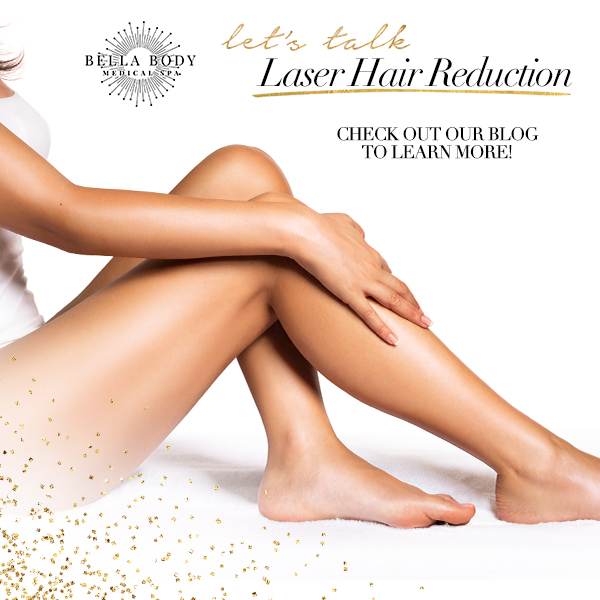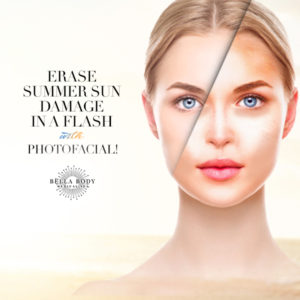Oct 17 2017 Let’s Talk Laser Hair Reduction
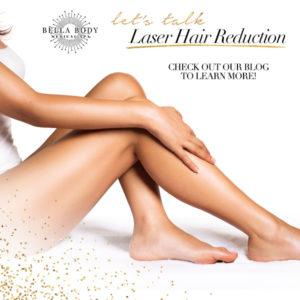 So, what is it that Lasers do?
So, what is it that Lasers do?Lasers are a device that uses light energy to eradicate the hair follicle. Therefore, hair growth is reduced due to the follicle being destroyed. It can be slightly painful, like a rubber band slapping you on each zap, but nothing that a little numbing cream can’t lessen.
Who is the ideal client for laser hair reduction?
The ideal laser client is someone that has lighter to medium dark complexion or a patient with a higher contrast between hair color and skin color and has darker, coarser hair. Therefore, anyone with lighter or whiter hair would not be an ideal candidate because they lack the targeted pigment the lasers are attracted to.
 When is the ideal time to start laser hair treatments?
When is the ideal time to start laser hair treatments?The fall is a great time to start receiving laser hair treatments because our skin must be free of any UV exposure or sunless tanner. Your skin is comprised after exposure to the sun therefore we would not want to sustain any damage or blistering to the skin. So once our tans have faded and we’re cozy in our sweaters, we should start our laser hair reduction to have reduced hair for the coming summer months!
Did you know…
Your hair grows in 3 stages. Hair growth in the active stage is the ideal time to have a laser treatment.
It takes time to catch every hair in that active stage so treatments are spaced out anywhere from 4-8 weeks.
Most clients will see an 85% reduction in growth on those coarse, dark hairs.
Certain disorders, such as, hirsutism and PCOS, can cause hair to continually grow even during a series of LHR because those with these conditions are more susceptible to have continued hair growth. While, most see a result and use it to help control the hair growth, it may take them longer to see results.
Pre- and Post Laser Hair Treatment…
Before your scheduled laser hair removal you want to be aware of any sun exposure you have had in the two weeks prior to your service or any sunless tanner that may still be on the skin. Most importantly, waxing or tweezing should not be performed 6 weeks prior to the start of your treatment and most importantly during your series. Again, we need the hair in that active growth stage to achieve the most effective result.
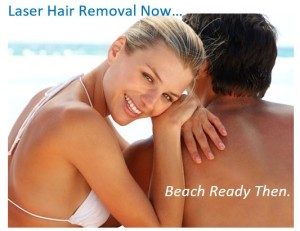 It’s time to ditch the razors for good!
It’s time to ditch the razors for good!Give us a call to set up your private consultation and schedule your first session. Get started now so you can enjoy razor smooth skin without shaving, for years to come! Take advantage of our Fall Special, Buy one area and we will add a second area complimentary. 215.622.7724 or hello@www.bellabodymedicalspa.com
Comments are closed.
Oct 17 2017 Erase Summer Sun Damage in a Flash
Now that summer is over and we are approaching fall we all want to know how we can clear up the damage that we have caused to our skin. Enter the IPL Photo Facial.
What happens to your skin in the summer sun?
Hyperpigmentation occurs when melanin is overproduced in certain spots of the skin. Pigment spots, such as age spots, are caused by sun exposure. They appear mainly on the face, chest, and hands. They tend to be small darkened patches of skin. Unfortunately, the UV radiation can sometimes be too much for this melanin to handle, so the skin reacts in a build up of darker cells that act as a protector, or “sunglasses”, for the over-exposed area of the skin.
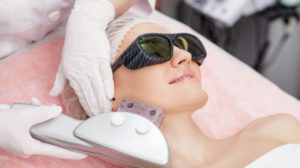
How can an IPL PhotoFacial help?
IPL treatments are most commonly used for lightening and removing sun spots and age spots along with reducing redness, rosacea, and broken blood vessels on the face, neck, and chest. This treatment also addresses skin tone and texture along with fine lines and wrinkles by stimulating collagen growth and larger pores by reducing the amount of oil the skin produces.
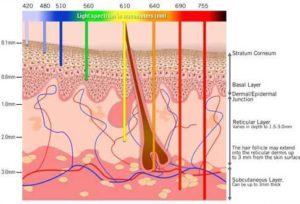
What is IPL doing to your skin?
IPL stands for Intense Pulsed Light and works by stimulating deeper tissues of the skin with a range of concentrated light. The lightwaves are targeted at hemoglobin (red blood cells) or melanin (brown pigment in freckles/age spots). The light beam passes through the skin and is absorbed by either the hemoglobin or melanin resulting in damage to the vessel wall or melanin pigment. These tiny vessels are then absorbed by the body rendering them less visible.
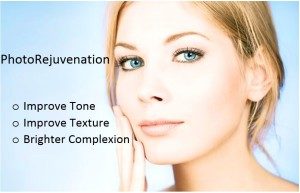
How will you look after a PhotoFacial?
Immediately after the treatment your skin will be slightly red. Any pigmentation will get darker right away and flake off like dry skin over 2-3 days. For veins, the skin will look slightly redder after the treatment for 2-3 days. Make-up can be applied right after the treatment. A healing foundation called Oxygenetics is available at Bella Body Medical Spa which can be applied following your treatment to help conceal any redness. Results are achieved with little to no discomfort or downtime. A minimum of 3 treatments every 4 weeks is recommended for optimal results.
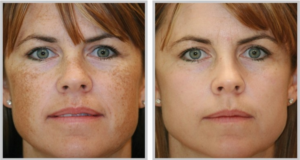
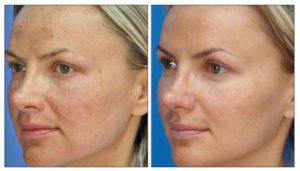
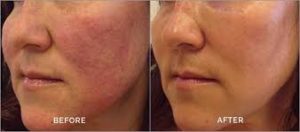
Set up your complimentary consultation with our Skin Care Experts to see how a PhotoFacial can benefit you, 215.622.7724. You can also learn more about our PhotoFacial here.
Comments are closed
Oct 17 2017 Who Needs Sunscreen on a Cloudy Day?
YOU DO! We all do. Every face should wear sunscreen, every day. Rain, Shine, Snow, Cloudy with a chance of meatballs, no matter the weather, your skin needs protection and that is what sunscreen does.
“Ultraviolet rays that are the cause of sun damage and skin cancer are always present, they are independent of cold or hot weather and are not blocked by clouds” explains Dr. Shilesh Iyer, M.D., a Board Certified dermatologist with the renowned New York Dermatology Group.
That well know term “UV” stands for Ultra Violet, a type of electromagnetic radiation. UV light, which comes from the sun, is invisible to the human eye and would be severely damaging to living things if not filtered by the earths atmosphere. It makes black-light posters glow, and is responsible for the telltale signs of over-exposure such as summer tans, freckles and sunburns.
Ultraviolet is also responsible for the formation of bone-strengthening vitamin D thus has effects both beneficial and harmful to human health.
UV has A rays and B rays. You have probably heard of them, but as many times as we have seen products that help protect against them, do we actually realize what they are doing?
UVA (aging) rays account for 95% of our sun exposure. They cause skin aging and contribute to skin cancer. UVA rays penetrate deeply into the skin layers, damaging collagen and cells which leads to wrinkling, hyperpigmentation and loss of elasticity. UVB (burning) rays mostly affect the outer layer of the skin. They cause sunburns and tanning that increase the risk of skin cancer and other disorders. The risk for skin cancer doubles in people who have had five or more sunburns. (Skin Cancer Foundation Nov. 2010)
“Broad-spectrum sunscreens” provide protection against both UVA & UVB rays. When wearing broad protection sunscreens, the UVA and UVB rays reflect and scatter away from your skin, providing you protection from sunburn and decreasing the risk of skin cancer and early skin aging caused by the sun.
There are two types of protection, physical and chemical. Chemical sun block contains organic (carbon-based) compounds, such as oxybenzone, octinoxate, octisalate and avobenzone, which create a chemical reaction and work by changing UV rays into heat, then releasing that heat from the skin.
Physical sunscreens contain active mineral ingredients, such as titanium dioxide or zinc oxide, which work by sitting on top of the skin to deflect and scatter damaging UV rays away from the skin.
Both are beneficial and provide excellent coverage when applied correctly and frequently.
We have a range of sun care options at Bella Body Medical Spa that include physical and chemical sunscreens such as Obagi, EltaMD and Brush on Block – a great “to go” sunscreen that you can toss in your bag and “brush on the sunblock” while on the go without removing makeup.
Give us a call if you have any questions. Our Anti-Aging Skin Care Experts can help guide you to the best protection for your pretty face, 215.622.7724
Comments are closed.
Oct 17 2017 Should I Use My Retin-A in the Summer?
Can I use my Medical Grade Skin Care Products with Tretinoin and Hydroquinone during the summer?
“Summer is actually a good time to start a retinoid: Humidity makes your skin less likely to dry out as it adjusts. Of course, apply sunscreen (SPF 30, at least) as diligently as you always do.” –Doris Day, MD
Absolutely! In fact, it is especially important to use your products during the summer when sun exposure is at its highest and skin’s susceptibility to sun damage is at its peak. If there was ever a time to correct and protect your skin, SUMMER is that time!
One of the misconceptions regarding Tretinoin is that it thins the skin and makes skin more susceptible to sun burn. Experts would disagree! Although this can appear true during your skin’s initial adjustment period (as skin can experience redness, sensitivity and irritation), with continued use of Tretinoin, the epidermis is actually thickened and strengthened. While your skin is adjusting to your retinoic acid/Tretinoin – as ALWAYS – it is important to use an SPF. With proper protection, you can experience the benefits of great skin care, all year long.
What do the experts say?
Suzan Obagi, MD, Associate Professor of Dermatology and Associate Professor of Plastic Surgery, Director, UPMC Cosmetic Surgery and Skin Health Center
University of Pittsburgh Medical Center hears this question a lot:
“Many patients ask if they should take a break from using their skincare products during the summer months. This stems from concerns with sun exposure and increased outdoor activities. However, I have oftentimes found that patients that need the NuDerm product line most are those with pigmentation issues such as melasma or post-inflammatory hyperpigmentation. These are conditions that typically flare and worsen during hot, sunny weather. In order for patients to have adequate control over these conditions, I recommend that they continue to use their NuDerm products as instructed. This goes hand in hand with sun avoidance during the peak hours of 10 am to 2 pm, wearing a hat when outdoors, and reapplying their sunscreen after sweating, swimming, or every 2 hours while outdoors. Furthermore, while ultraviolet ray B (UVB, the burning ray) increases during the summer, UVA (the aging ray) remains constant all year. Therefore it is imperative to use a daily, broad-spectrum sunscreen such as Obagi Sun Shield. I recommend it even while driving or working under fluorescent lights, as these are sources of ultraviolet light exposure that most patients do not realize.”
Doris Day, MD, is also renowned for her expertise and is a leading expert on dermatology and aesthetic dermatology. Dr. Day is affiliated with Lenox Hill Hospital in New York City and is a clinical associate professor of dermatology at the New York University Langone Medical Center where she was presented with the award for Dedication and Excellence in the Teaching of Dermatology. According to Dr. Day with regard to retinoid usage and sensitivity: “This is one of the biggest retinoid myths,” says Doris Day, MD, (a Tretinoin user herself). “The ingredient itself is sensitive to sunlight, which is why you should apply it before bed at night. A retinoid shouldn’t make your skin any more vulnerable to UV rays than it would be after buffing away dead skin with a face scrub. Summer is actually a good time to start a retinoid: Humidity makes your skin less likely to dry out as it adjusts. Of course, apply sunscreen (SPF 30, at least) as diligently as you always do.”
Is there anything extra I can do to protect my skin during the summer months when sun exposure is at its peak?
In addition to using a sunscreen, incorporate a topical antioxidant into your morning skin care routine. Antioxidants help in the fight against free radical and sun damage. They help stabilize collagen, which helps reduce the aging effects the sun inflicts on our skin. Vitamin C in the form of L-ascorbic acid is believed by many experts to be the most stable and effective in protecting skin. Obagi offers a full portfolio of vitamin C (l-ascorbic acid) products: Pro C formulas 10%, 15% and 20%. Apply a few drops, first thing in the morning, after cleansing and toning. (Be careful to avoid the eye area if you’re using Elastiderm Eye Cream as Elastiderm contains a copper peptide which neutralizes the benefits of the copper and C when the two ingredients come into contact.)
Stopping your medical grade products in the summer increases your chance for additional, untreated photo damage – the very thing we are trying to correct and avoid.
During the summer months, it is important to continue use of products keeping pigmentation in check, as well as improving texture, tone, and laxity issues.
Confidently enjoy your products and wonderful skin all year long!
If you have questions about which products are right for your skin, our anti-aging experts at Bella Body Medical Spa can help. Schedule a complimentary consultation to discuss what’s best for you. 215.622.7724Comments are closed.

